If you’ve noticed blackened branches or scorched-looking leaves on your trees this spring, fire blight might be to blame. This aggressive bacterial disease (not actually a fungus!) affects many common trees in Colorado, especially apple and pear species. And if left untreated, it can spread rapidly and kill large sections of a tree.
Here’s what Colorado homeowners and land managers should know about fire blight, how to spot it, and what to do next.
No, fire blight is not a fungus — it’s a bacterial disease caused by the pathogen Erwinia amylovora.
This is a common misconception because it spreads and damages trees in ways that can look similar to fungal infections. But unlike fungi, which produce spores, fire blight bacteria multiply and spread through tree tissue, wounds, and blossoms, especially during wet spring weather followed by warmth.
Despite its name, fire blight is caused by a bacterium called Erwinia amylovora, not a fungus. It infects trees through blossoms, wounds, and natural openings, especially during cool, wet springs followed by warm weather — which we often see across Colorado’s Front Range.
Once inside the plant, the bacteria multiply quickly and spread through the tree’s vascular system, damaging tissues and causing the “burnt” appearance that gives fire blight its name.
Fire blight primarily affects members of the Rosaceae family, including:
Crabapple trees (very common in Colorado landscaping)
Apple and pear trees (both ornamental and fruiting varieties)
Mountain ash
Hawthorn
Serviceberry
Cotoneaster
These trees are popular throughout the state for their spring blossoms and hardiness, which unfortunately also makes them frequent fire blight victims.
Look for these telltale signs:
Scorched blossoms: Flowers wilt suddenly and turn brown or black.
Shepherd’s crook shape: Infected twigs curl downward like a cane.
Oozing cankers: You may see amber-colored ooze coming from infected bark.
Rapid dieback: Entire limbs can brown and die within weeks of infection.
Often, fire blight spreads so quickly that a tree can go from healthy to heavily damaged in a single growing season.
Colorado’s changing spring temperatures and periods of moisture can create ideal conditions for fire blight to thrive. Once the bacteria are present, pruning alone may not be enough — and improper cuts can actually spread the infection.
Because many homeowners in areas like Denver, Boulder, and the foothills plant susceptible species, entire neighborhoods can experience outbreaks that move from tree to tree.
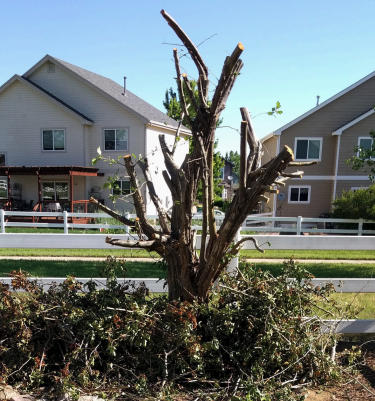
A large portion of this crabapple tree was pruned away because of fire blight. Pruning away dead branches and leaves is not advised in summer time.
1. Prune infected branches.
Cut at least 8–12 inches below visible infection. Sterilize pruning tools between cuts with alcohol or bleach solution to avoid spreading bacteria.
2. Avoid excessive nitrogen fertilizer.
Too much nitrogen encourages lush, new growth — which is especially vulnerable to infection.
3. Apply a bactericide.
Copper-based sprays can help, especially if applied during bloom. However, they must be timed correctly and applied by professionals to be effective.
4. Remove severely infected trees.
In some cases, tree removal is the best way to prevent fire blight from spreading to nearby trees.
5. Call a certified arborist.
Professional tree care companies in Colorado are equipped to diagnose, treat, and manage fire blight outbreaks safely and effectively.
6. Learn more about fire blight from Colorado State University:
If you suspect fire blight is affecting your trees, don’t wait. Early intervention can save the tree — and keep it from spreading to others nearby. At Splintered Forest, our ISA-certified arborists offer plant health care services across Colorado’s front range, including fire blight identification and treatment.
Call us today to schedule a tree inspection or request a free quote.
Protect your property and Colorado’s forests with professional fire mitigation services. Splintered Forest specializes in reducing wildfire risk through strategic tree removal, defensible space creation, and expert assessment to keep your home and community safer.
Wildfires are an ever-present threat in Colorado, especially for those living in the wildland-urban interface (WUI). Creating and maintaining defensible space around your property is a critical step in safeguarding your home and community. Here’s what you need to know to get started.
As wildfires have become more frequent and more destructive in recent years in Colorado. Whether you’re located in the foothills, nestled in the forest, or near the wildland-urban interface, fire mitigation is no longer optional—it’s essential. At Splintered Forest, we help Colorado homeowners reduce their wildfire risk through professional defensible space inspections, strategic fire mitigation, and forestry services.
Defensible space refers to the buffer zone you create between a building and the grass, trees, shrubs, or wildland area that surrounds it. This space is designed to slow or stop the spread of wildfire and protect your home from direct flame contact, radiant heat, and ember intrusion.
Creating a defensible space isn’t just about trimming branches. It’s about zoning your property into three strategic areas—each requiring specific treatment.
Regular Maintenance: Continuously monitor and maintain your defensible space, especially during fire season.
Home Hardening: Use fire-resistant building materials for roofs, siding, and decks. Install ember-resistant vents and screens.
Community Engagement: Participate in local fire mitigation programs and stay informed about fire risks in your area.
Wildfires are an increasing threat across Colorado’s Front Range. As our communities grow closer to wild land areas, the need for proactive fire mitigation has never been more urgent. At Splintered Forest Tree Services, we specialize in helping homeowners, HOAs, and property managers reduce wildfire risks by creating and maintaining defensible space—a proven method for protecting structures from wildfire damage.
Defensible space is the area between a building and the surrounding vegetation that’s strategically managed to reduce fire danger. Creating this buffer slows the spread of wildfire, reduces fuel, and provides firefighters with a safe zone to defend your home.
The Colorado State Forest Service and Wildfire Partners recommend a zoned approach, dividing your property into three defensible zones based on their proximity to your home.
Remove all flammable vegetation and debris.
Relocate firewood, mulch, and outdoor furniture made from combustible materials.
Clean gutters and roofs regularly to remove pine needles and dry leaves.
Use non-flammable landscaping such as gravel, stone, or pavers.
Space trees at least 10 feet apart and prune lower branches.
Remove ladder fuels (vegetation that allows fire to climb from ground to canopy).
Keep grass mowed to under 4 inches.
Create breaks with hardscaping like patios or driveways.
Thin out dense trees and shrubs to reduce overall fuel load.
Remove dead trees, fallen branches, and leaf litter.
Maintain clear access for emergency vehicles.
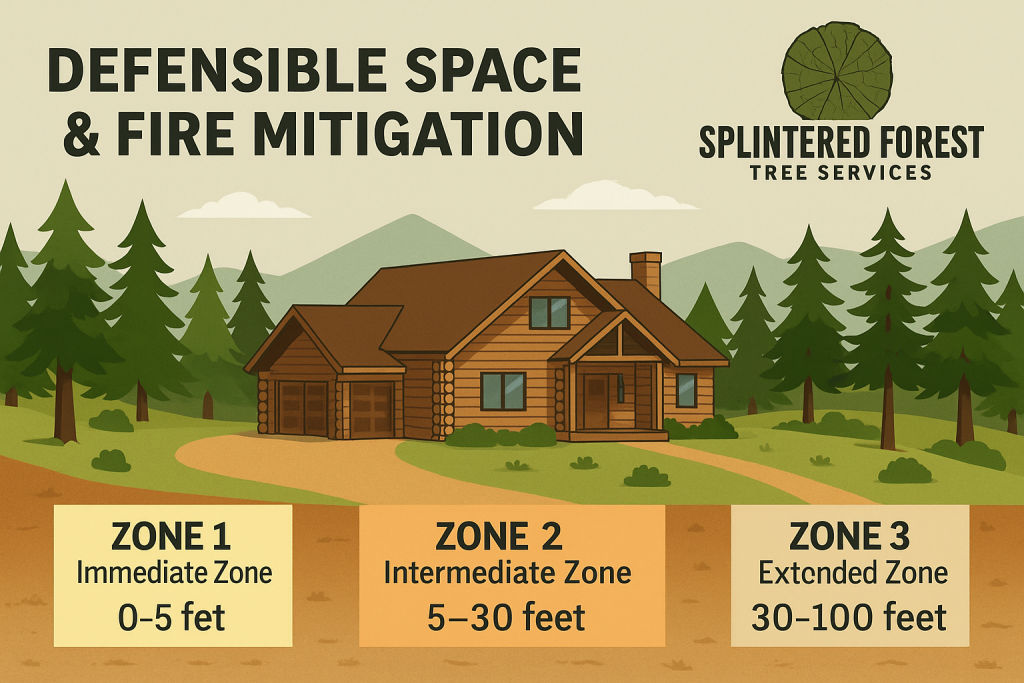
Colorado’s arid climate, wind-prone weather, and dry vegetation make it highly susceptible to fast-moving wildfires. Many homes lost to wildfire are ignited by embers, not direct flames—meaning preparation around your home’s perimeter is crucial.
Defensible space isn’t just a suggestion—it’s often required. Many counties in Colorado now require fire mitigation inspections for new construction, property sales, or insurance compliance. Splintered Forest offers county-approved defensible space assessments that meet local regulations and help you stay compliant.
To check out more wildfire mitigation basics and resources visit Colorado WILDFIRE PARTNERS!
A fire mitigation inspection from Splintered Forest includes:
We follow Firewise Colorado and national safety standards to ensure every property meets or exceeds wildfire readiness guidelines.
We also work with property managers, apartment complexes, and HOAs throughout the Front Range to create fire-adapted communities. If you manage multiple residences, creating a long-term mitigation plan is essential to protect not only property, but lives. We provide:
Bulk defensible space clearing
Hazardous tree removals
Fire mitigation planning
Ongoing maintenance contracts
Our certified arborists understand more than just tree removal—we know how to assess risk based on slope, tree species, wind exposure, and your property’s layout. We don’t just clear land—we build fire-resilient landscapes. Our team works hand-in-hand with local regulations and wildfire mitigation programs, making us a trusted partner in high-risk areas.
Any structure exposed to fire risk, including homes, garages, decks, and sheds.
Our Defensible Space Inspectors (DSI) will mark and measure this for you during your site visit.
It varies by tree density, slope, and accessibility. We also help clients take advantage of Colorado fire mitigation tax credits and wildfire mitigation grants.
Here’s your quick action list:
Splintered Forest offers complete fire mitigation services for Colorado’s Front Range and foothills, including Golden, Evergreen, Conifer, and surrounding communities.
Wildfire season isn’t waiting. Whether you live in Evergreen, Conifer, Boulder, or anywhere in Colorado’s Front Range, creating a defensible space could make all the difference when a fire sparks. Our team of certified arborists and fire mitigation specialists is trained in Firewise practices, fire zoning, and wildfire defense. Whether you need a full-service plan or just want a second opinion, we’re here to help keep your property safe.
Contact Splintered Forest Tree Services today to schedule a defensible space assessment or get help navigating local fire mitigation requirements.
At Splintered Forest Tree Services, we specialize in creating defensible spaces tailored to your property’s unique needs. Our certified arborists provide:
Comprehensive assessments of your property’s fire risk.
Customized plans to establish and maintain defensible space.
Assistance with local regulations and compliance.
Protect your home. Create defensible space. Schedule your fire mitigation inspection with Splintered Forest today.
From Egg to Invading: The Full Emerald Ash Borer Life Cycle
The Emerald Ash Borer or more commonly referred to as EAB goes through many cycles before emerging as a mature adult. Continue reading to learn more about each part of the invasive pests life cycle.
The life cycle of the emerald ash borer repeats annually:
Understanding this cycle is key to preventing infestations and maintaining the health of ash trees. The emerald ash borer life cycle is synchronized with seasonal changes, meaning effective management must be timed correctly.
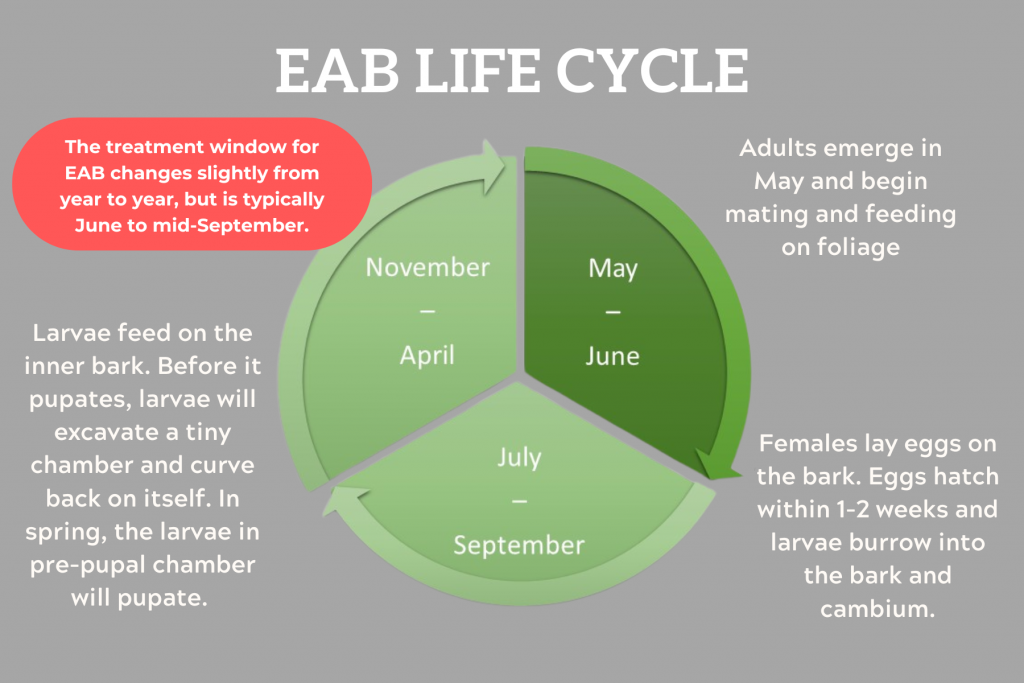
Eggs are approximately 1mm in size and laid by females in the cracks and crevices of the bark of ash trees. Females can lay anywhere from 40 to 200 eggs that will hatch about two weeks later. Upon hatching the larvae will then burrow into the trees inner bark layers and begin to feed.
The emerald ash borer egg is a critical but often overlooked stage in the EAB life cycle. These eggs:
Since EAB eggs hatch quickly, preventive treatments should be applied in early spring before larvae emerge.
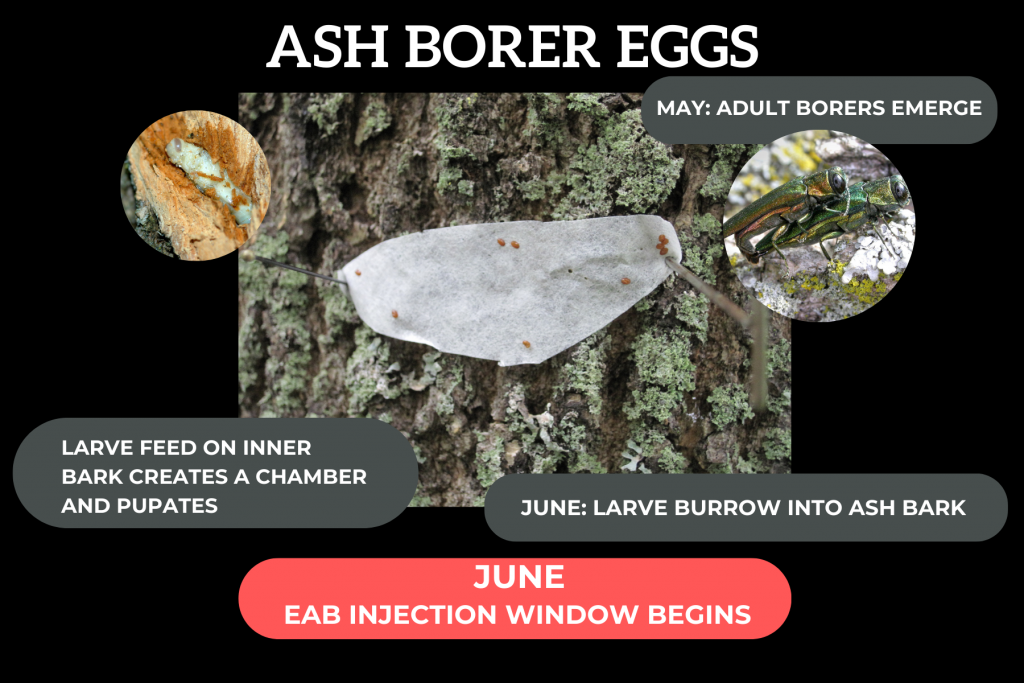
The larval stage is the most dangerous stage of the beetles life. Larvae tunnel into the bark upon hatching from their eggs. They then spend all of their time eating tissues that the tree would need to transport water and nutrients. This damage of vital tissues can quickly become deadly to the ash tree because of the number of larvae doing damage and their aggressive nature. As they feed their movements form a distinct S-shaped pattern which can be seen when bark is removed. This is the stage most often selected to chemically treat an infestation as the larvae will feed on treated wood and then die.
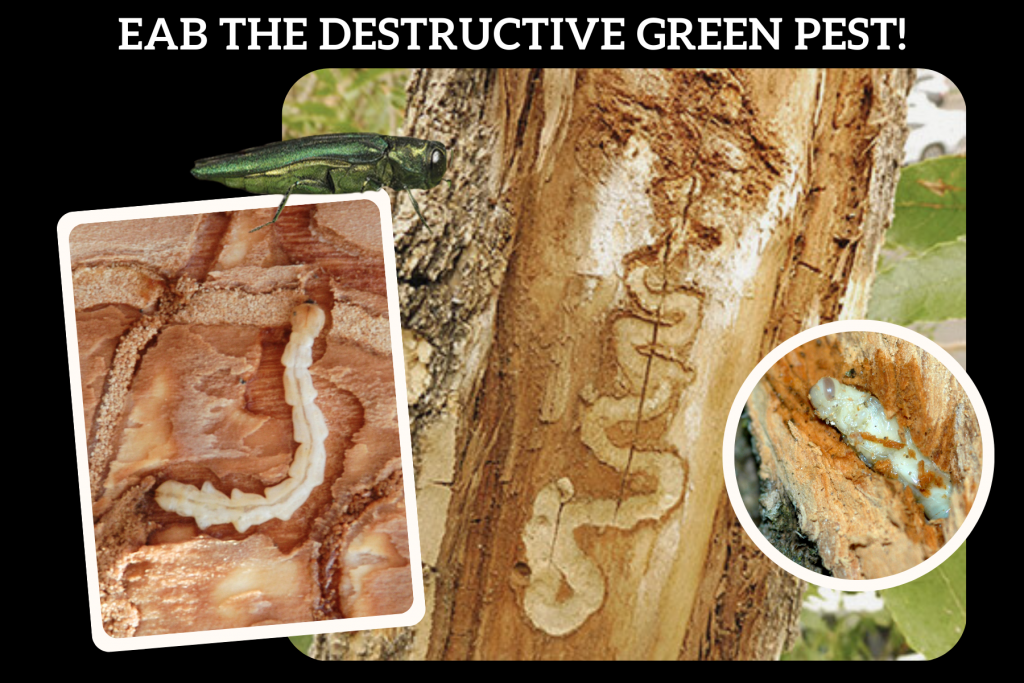
The emerald ash borer larva is the most damaging stage of the EAB life cycle.
Once larvae are present, systemic insecticides or tree removal may be the only options.
Overwinter
After feeding on tree matter for one to two years, the larvae will overwinter and begin to pupate in the spring. This overwintering in the tree keeps the larvae and pupae safe from cold weather and potential predators.
Pupae
The pupa is the final form before emerging as a mature adult. It merely is a stage to facilitate metamorphosis to the final adult beetle stage.
Adults
Adults can emerge any time between late-May and September, but the majority of them will emerge by July and begin to mate and lay eggs. As they exit, they form D-shaped exit holes which can be used to identify the beetle’s presence in a tree. The adult form does minimal damage to the tree as they usually feed on the leaves of the tree and mate before dying, but their ability to fly up to a quarter mile aids in their spread.
The Emerald Ash Borer (EAB) poses a significant threat to ash trees, causing extensive damage throughout its life cycle. Recognizing the signs, exploring treatment options, and understanding preventive measures are crucial for preserving these valuable trees.
Identifying signs of EAB damage is vital for early intervention. Look for distinct D-shaped exit holes left by emerging adults, as well as canopy thinning, bark splits, and epicormic shoots—new growth arising from the tree’s base or trunk. Recognizing these indicators early can be instrumental in minimizing the impact on ash trees.
Timely treatment is essential to combat EAB infestations. Various methods, including chemical treatments and insecticides, are available. Chemical treatments during the larval stage can effectively control the population by targeting feeding larvae. Consulting with arborists or plant health care professionals is recommended to determine the most suitable treatment approach for specific situations.
Implementing preventive measures is crucial in areas prone to EAB infestations. Regular inspections, early detection, and prompt treatment can help protect ash trees. Consider systemic insecticides that are absorbed by the tree, providing long-term protection against EAB. Establishing a proactive treatment plan can significantly enhance the resilience of ash trees.
Stay informed about the geographical distribution of EAB through maps tracking its presence. Understanding the areas affected can guide proactive measures and help prevent the spread of this invasive species.
Knowing where the EAB originated is essential for understanding its introduction to new regions. The beetle is native to Asia and likely arrived in the United States through international trade. Tracking its spread provides valuable insights for managing and mitigating its impact.
Colorado, including the Denver Metro area, has witnessed the invasion of EAB. Being aware of local infestations, understanding treatment costs, and collaborating with professionals is crucial for effective management.
Examining the transformation of ash trees before and after EAB damage showcases the severity of infestations. Utilizing visual aids, such as damage maps, illustrates the impact and emphasizes the importance of proactive measures.
Distinguishing between EAB and similar-looking beetles is essential for accurate identification and treatment. Identify EAB look-a-likes:
See the University of Nebraska EAB Look-a-likes chart. EAB adults are smaller than a penny approximately 8-13 mm long. They are about the size of a cooked grain of rice: between 3/8- and 1/2-inch long and 1/16-inch wide. Due to their size, they can often go undetected, but they can be seen on ash bark and leaves during warmer months, at this time they might attract woodpecker activity.
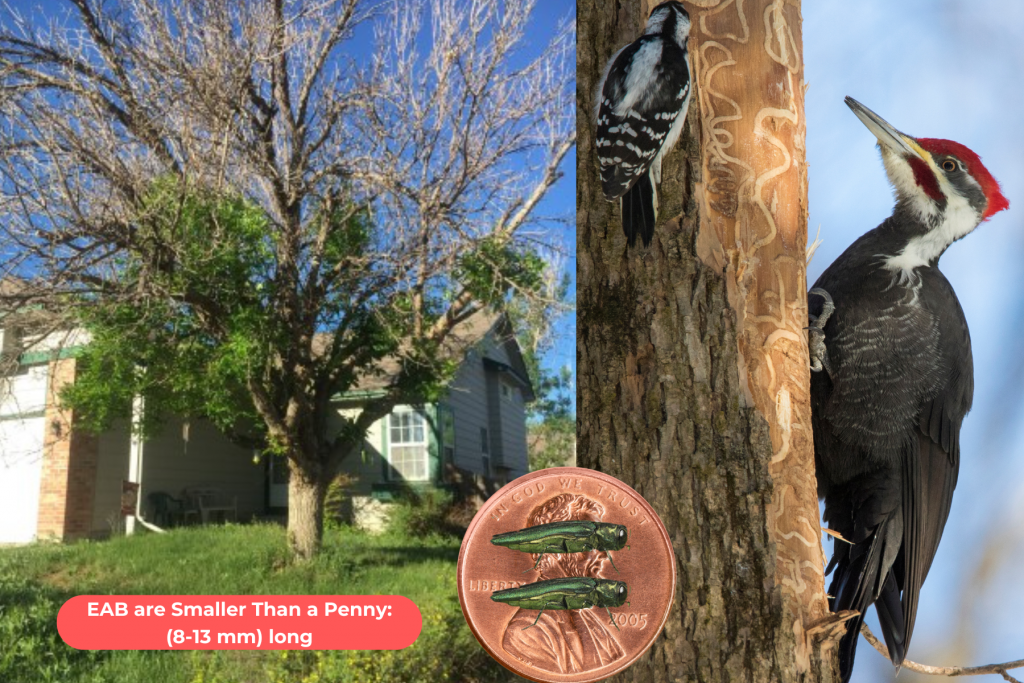
Do you live in the Denver Metro area? Do you have an ash tree on your property? The EAB has been detected most recently in the Littleton area and continues to spread. Contact the team of Plant Health Care professionals at Splintered Forest to create a maintenance plan to protect your landscape today! Give us a call at 303-819-9840 extension 1 or visit us online to submit your request for a free estimate.
Read more about the impact of the emerald ash borer (EAB) on local ecosystems is a growing concern for Colorado residents.
Learn the best practices for protecting Ash trees from EAB and ensuring their long-term health.
Interested in EAB Injections for your ash trees. In our next post we break down the science of THE EAB INJECTION PROCESS.
Schedule Now at Save My Ash.
In recent years, wood chip landscaping has gained popularity among garden enthusiasts. This natural material not only enhances the aesthetic appeal of your garden but also provides various benefits for the plants. If you’re looking to create a beautiful, sustainable garden, understanding the basics of wood chip landscaping is essential.
Wood chip landscaping is a popular choice for many gardeners due to its versatility and functionality. By incorporating wood chips into your garden, you can enjoy a range of benefits that will enhance the overall health and appearance of your outdoor space.
Wood chips are small pieces of wood that have been processed from various tree species. They can be obtained from local tree service companies or by chipping your own tree trimmings. These chips are an excellent landscaping material that can be used in a variety of ways to improve your garden.
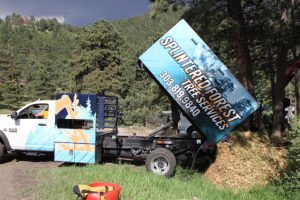
There are several advantages to incorporating wood chips into your garden:
In addition to these benefits, wood chips also add aesthetic appeal to your garden. They provide a natural and rustic look that can complement various garden styles, from formal to informal. Whether used as a pathway material, a mulch around plants, or as a decorative element in garden beds, wood chips can enhance the visual appeal of your outdoor space.
When using wood chips in your garden, it’s important to consider the type of wood being used. Some tree species, such as cedar or cypress, are more resistant to decay and can last longer as mulch. It’s also essential to apply wood chips at an appropriate depth to maximize their benefits without smothering plant roots.
Overall, wood chip landscaping offers a range of advantages that can significantly improve the health and beauty of your garden. By incorporating wood chips into your landscaping practices, you can create a sustainable and thriving outdoor environment that you can enjoy for years to come.
When it comes to selecting wood chips for your garden, there are several options to consider. Each type of wood chip has its own unique characteristics and benefits. By understanding these differences, you can make an informed decision that will best suit your gardening needs.
Let’s take a closer look at the different types of wood chips available:
Before making a purchase, it’s important to consider the following factors:
By considering these factors and understanding the different types of wood chips available, you can make an informed decision that will benefit your garden in the long run. Remember, the right wood chips can not only enhance the aesthetics of your garden but also contribute to the overall health and vitality of your plants.
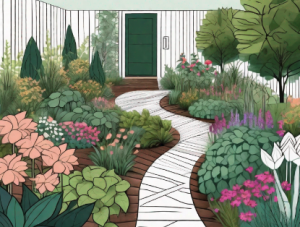
Prior to applying wood chips, make sure to prepare your garden appropriately:
Follow these steps to properly apply wood chips in your garden:
To keep your wood chip landscape in top condition, maintenance tips:
Occasionally, you may encounter common issues with your wood chip landscape:
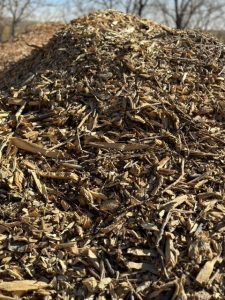
Wood chip landscaping aligns with sustainable gardening practices in several ways:
To minimize the environmental impact of your garden, consider implementing the following practices:
Wood chip landscaping is a versatile and sustainable option for creating a beautiful garden. By understanding the basics, choosing the right wood chips, and applying them correctly, you can enjoy the many benefits they provide. Regular maintenance and sustainable practices will ensure your wood chip landscape thrives while minimizing its environmental impact. Embrace this natural material and transform your garden into a captivating oasis.
Have wood chips delivered right to your property, school or community garden!
Planting fruit trees in Colorado can be incredibly rewarding, but the unique climate and growing conditions require careful planning and maintenance. With the right tree selection, proper pruning techniques, pest management strategies, and ongoing care, you can enjoy fresh fruit from your own backyard for years to come.
Pruning your fruit trees is a key part of caring for your fruit tree.
Mature trees: Maintaining good airflow and structure in older trees is the most important thing. Over pruning can be harmful to your tree so keeping cuts to a minimum and avoiding unnecessary cuts is the goal.
Young trees: Young trees are easier to work with in terms of pruning because of their faster growth patterns and lack of older mature branches. Young trees can also be pruned to fit specialty structure methods like espalier.
Fruit trees can be difficult to care for in terms of diseases and pests as some varieties are prone to common diseases like fireblight and cytospora canker. These diseases can add extra cost to the care of your trees, but are avoidable if you care for your tree properly. Preventative sprays can help to mitigate repeat infections from fireblight in the chance that your tree becomes infected, but the best method for protection is timed pruning in the dormant season.
Fruit trees do not bear fruit right away – in most cases it will be about three years until the tree begins bearing fruit.
Some tree varieties are susceptible to fireblight which is a bacterial disease so additional costs to protect them may be necessary.
Fruit trees grow relatively slow so they will need extra care for the first few years after planting.
Fruit trees should only be pruned when the tree is dormant unless absolutely necessary.
Proper fertilization of your fruit trees can improve health and fruit production.
Pruning is one of the most important steps in maintaining the health and productivity of your fruit trees. It helps shape the tree, encourage better fruit production, and prevent disease by improving airflow and sunlight penetration. However, improper pruning can do more harm than good, so it’s important to follow best practices based on the tree’s age and growth stage.
Older fruit trees require pruning to maintain structure, reduce overcrowding, and ensure that branches get adequate airflow and sunlight. Without proper pruning, excessive growth can lead to weaker limbs, reduced fruit production, and increased susceptibility to disease.
Pruning young trees is essential for developing strong branch structure and establishing a solid foundation for future growth. Young fruit trees tend to recover quickly from pruning and can be shaped using specialty techniques.
Pruning should always be done during the dormant season (late winter to early spring) before new growth begins. Summer pruning is only recommended for removing minor deadwood or shaping the tree slightly.
Colorado’s climate can present challenges for fruit tree growers, particularly when it comes to common pests and diseases. Many fruit tree varieties are susceptible to bacterial and fungal infections, as well as insect infestations, so proactive care is essential.
Regular monitoring, proper pruning, and well-timed applications of organic or chemical treatments can keep fruit trees healthy and productive.
Before planting a fruit tree, it’s important to set realistic expectations. Unlike vegetable plants or fast-growing shrubs, fruit trees require patience and long-term care before they produce a harvest.
If you’re considering adding fruit trees to your landscape, here are some best practices for planting and establishing strong trees:
Fruit trees are an investment, but with proper care, they can provide decades of fresh, homegrown fruit. If you need guidance on planting, pruning, or pest management, our arborists can help you every step of the way.
Whether your tree is mature or you’re looking into planting a new fruit tree, making sure your tree is healthy and free of pests and diseases will help to ensure your tree doesn’t die and produces plenty of fruit.
Next, learn more about how to stabilize a leaning tree. Discover the best practices for growing healthy fruit trees in Colorado’s unique climate with Growth Regulators. We have helped many customers with their tree problems in Colorado, but you don’t have to take our word for it. Visit Splintered Forest Customer Testimonials page to see what our customers are saying. Contact the team at Splintered Forest today to create a treatment plan today!
Ash trees are a popular native tree species in the United States and are often planted as street or landscape trees. Ash trees are part of the Fraxinus genus and there are various species of ash trees in Colorado, including green ash and white ash. It is common to confuse an Ash tree with various other trees that look similar, such as black walnut, maple, boxelder, hickory, or dogwood trees. To correctly identify ash trees, you will need to closely examine various parts of the tree.
To start identifying an ash tree, you can look at its branches. You can either pick up a dead stick that has fallen to the ground or pull down a branch so you can get a close look at it. Check to see if the branches have opposite branching. This means that when branches grow from the main branch, they all start at the same position. Other trees feature alternate branching, with branches growing from the main branch alternating left and right. For example, maple, dogwood, and boxelder trees have opposite branching, while oak, cottonwood, and hickory trees have alternating branches. You can also look for fresh branch buds. On ash trees, the buds will be directly across from or opposite each other. Here are more Useful Tree Resources to explore.
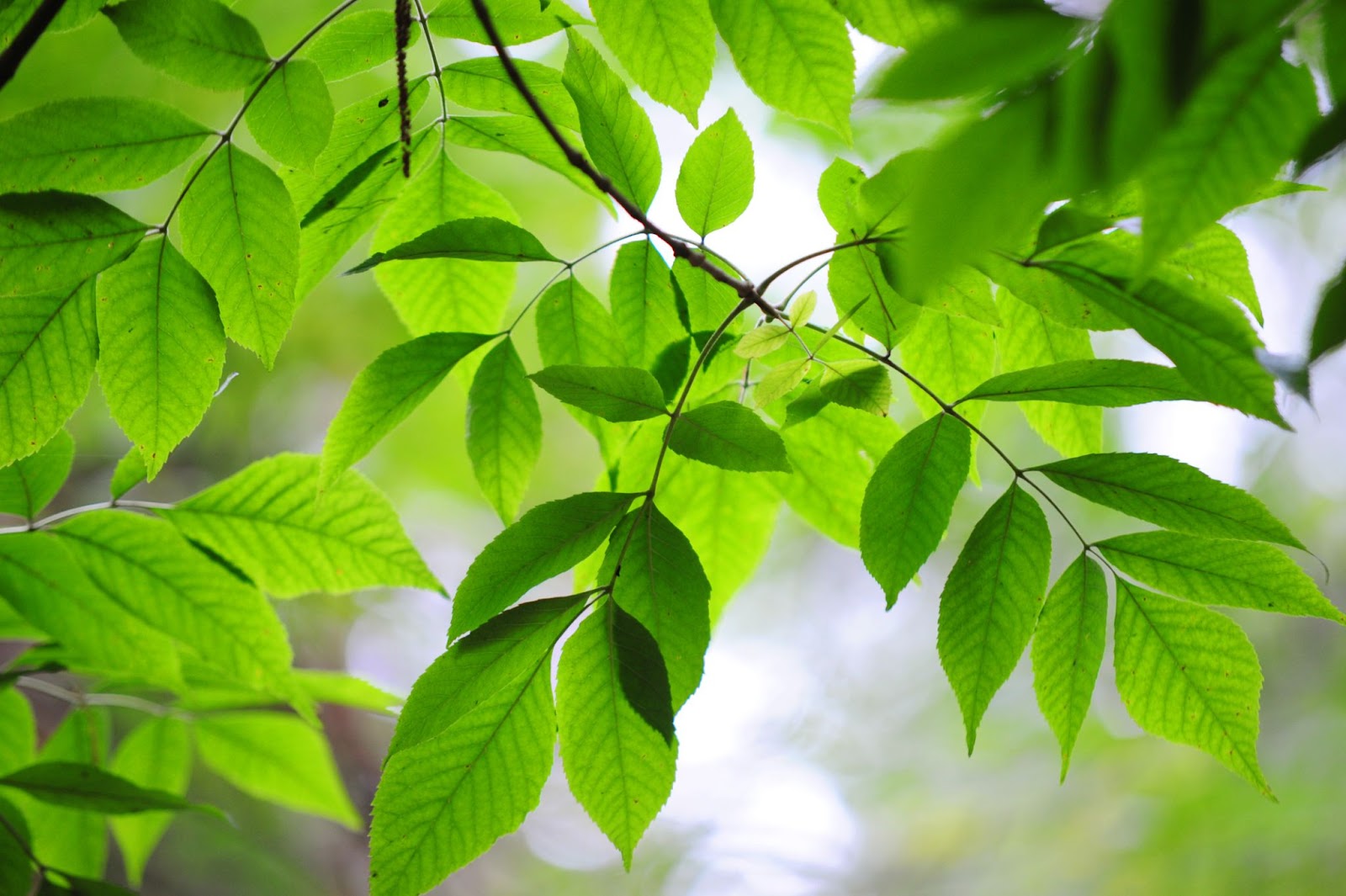
Another way to confirm that you have an ash tree is to look at its leaves. The leaf structure of an ash tree is compound rather than single. From this point you can count the number of leaves. You will either see a single leaf or 5 to 7 (some varieties have up to 11) smaller leaflets that branch out from it. A single leaf tree, such as a maple tree, has one big leaf that extends from the branch. Both ash trees and boxelder trees have compound leaves, so be careful with getting them confused. Another characteristic of ash tree leaves is that they have either smooth or finely toothed edges.
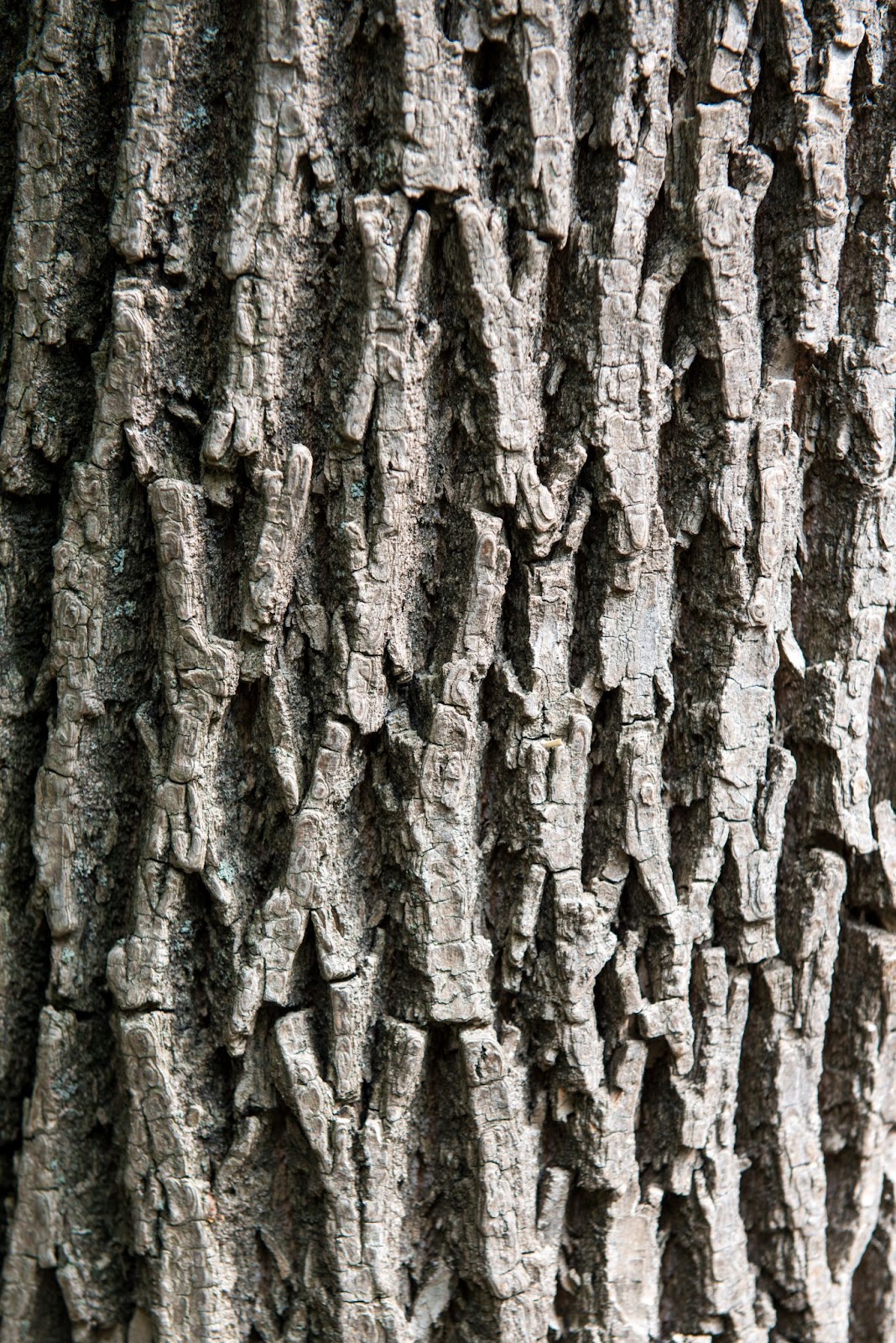
If you are looking at a mature ash tree, the bark can help with identification, too. Ash trees will have a diamond-shaped bark pattern on both white ash and green ash trees. This helps differentiate them from maple trees. Young ash trees may not have this distinctive bark pattern, but you should be able to rely on other characteristics if this is the case.
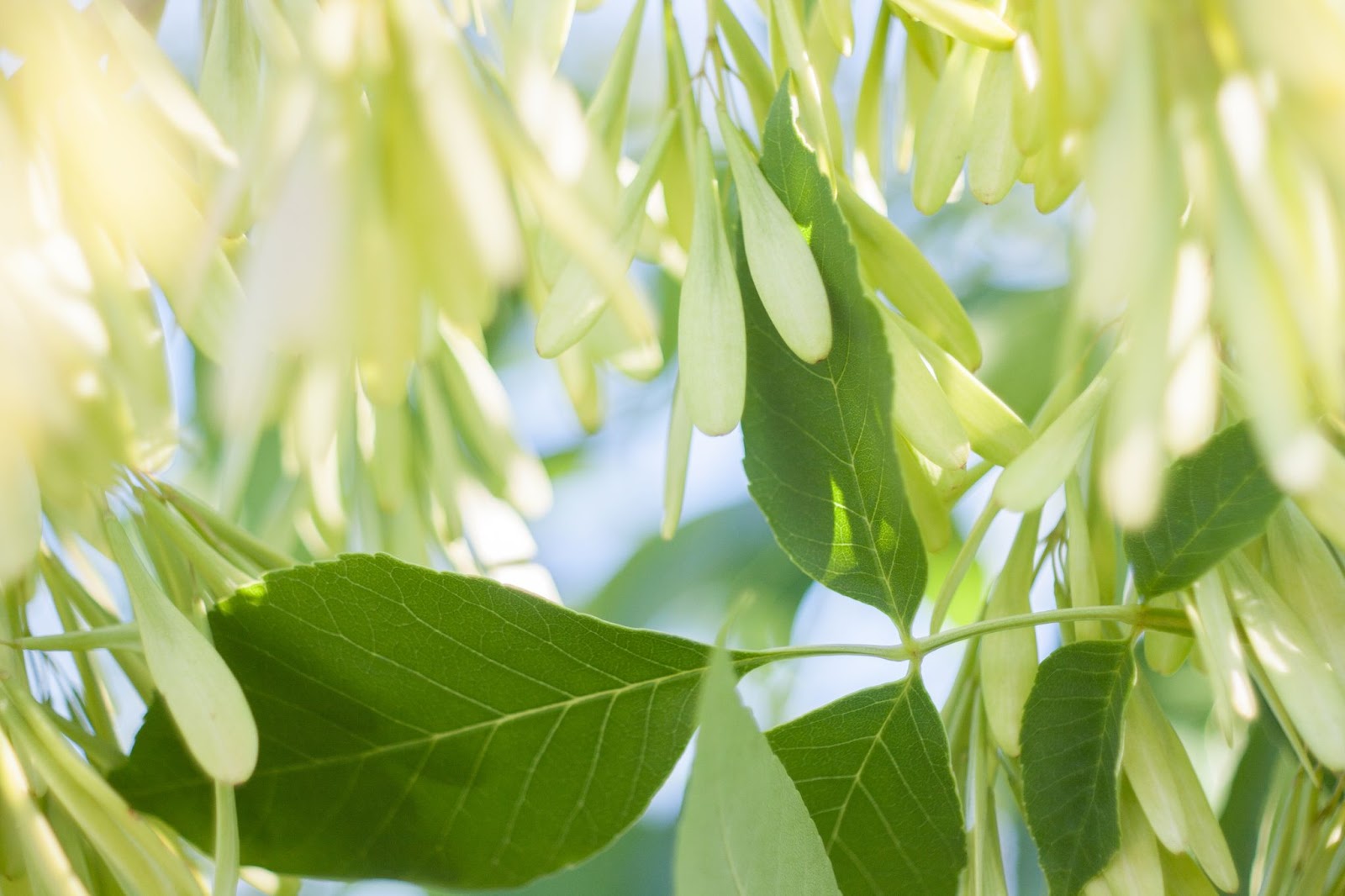
An ash tree will have either light green or brown clusters of seeds (known as a Samara). The seeds on an ash tree are paddle-shaped and resemble small leaves and dangle from the tree in big clusters. Don’t assume that a tree that lacks seeds isn’t an ash tree. Some ash trees are seedless. Only in late autumn and early winter can seed clusters develop. Boxelder/maple seeds are similarly clustered, although they resemble wings rather than paddles.
Knowing whether or not you have an ash tree on your property is important, especially in the state of Colorado. The Emerald Ash Borer (EAB) made its way to Colorado in 2013, and this pest has become a serious threat to ash trees. If you have an ash tree that has been infested with the Emerald Ash Borer, you will want to contact a professional to treat infected trees as soon as possible. EAB can be prevented, so if you live within 15 miles of a known EAB infestation, you may want to consider treating your ash trees.
Ash trees are diverse, with several common ash species spread across various regions. By understanding the distinguishing characteristics of these trees, including their leaf shape, bark texture, and seasonal changes, you can confidently identify different types of ash trees.
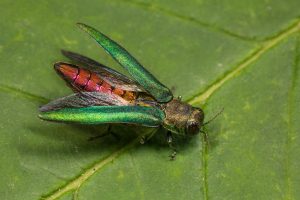
One of the greatest threats to ash trees globally is the emerald ash borer (Agrilus planipennis). This invasive insect targets ash trees by burrowing under the bark, disrupting nutrient flow, and eventually killing the tree. The emerald ash borer has particularly impacted green ash and white ash populations, leading to extensive conservation efforts.
Ash trees are often recognizable by their bright green leaves, especially in the spring and summer months. Each ash species has its unique leaf arrangement and fall colors, aiding identification:
By examining these visual clues, tree enthusiasts and landscapers can better identify each ash species and support efforts to protect them from pests like Agrilus planipennis.
If you’re having issues with your ash trees or any other type of tree on your property, Splintered Forest can help. Our crew includes ISA Certified Arborists, experienced tree climbers, and expert tree fellers. If you are seeing emerald ash borer signs of damage, contact us today to schedule your free, no obligation estimate.
To Schedule Ash Tree Injections for EAB visit Save My Ash
There are many reasons you may need to have a tree removed. At times, diseased or dying trees will need to be removed to ensure there is no damage to the house itself. Also, there are safety issues involved and otherwise perfect trees must be removed. If you must remove trees around your home, consider repurposing wood! You could use it in a variety of ways from furniture to shelving and keep elements of your once tall trees in your Denver home.
Transforming and repurposing old wood into a table is a fantastic way to add a custom style in your home. Depending on the style of your home, you can make or have a table made to fit. For farmhouse or traditional homes, consider a table made completely of wood. Create a long wooden table paired with a gorgeous color stain that helps it fit with other colors in the room. For modern or contemporary homes, consider a wood top with a metal or pipe bottom and legs. This unique style will stand out and provide flair to your home. Pair it with a pair of custom made wooden chairs. In addition to chairs, consider making wooden stools of your repurposed wood, or add a bench on one side of your table. Have a large backyard? Consider adding a picnic table or chairs made from your old tree’s wood!
Can you ever have enough storage space? Repurposing wood as a cabinet or shelf is a great addition to your home! Plus, you will have complete control and can build or have something build perfectly for an area. For instance, choose a corner cabinet to store dishes, essentials, supplies and more. Once it is built, you can add a stain to it, or paint it a color that matches other elements of the room. Next, wood shelving is a very durable option. From thick to thin shelves, you can really have fun and play with some great ideas that look great in any room. You can also put wood shelves on a grid system or using metal or steel pieces to mount them on the wall.
Use your reclaimed wood to transform your bedroom. Many love the way a wooden structure looks. However, that is not your only option! You can complement your current bedroom arrangement with a wooden headboard. There are so many options to customize a headboard. The wood can also be great to customize nightstands that are connected to your bed or stand-alone. Wood can also create a gorgeous vanity or dresser for essentials or a way to help you get ready in the morning.
Need some inspiration? Check out Country Living’s 22 Easy DIY Reclaimed Wood Projects for Your Home.
If you suspect that you have trees that need to be removed, Splintered Forest can help! Let our crew create a safe and aesthetically pleasing area around your home – we can even remove trees right next to your home or a structure! Look through our tree trimming and removal photo gallery and give us a call at 303-819-9840 for a free estimate.
Explore our various tree removal services.